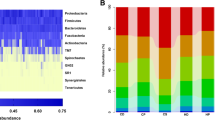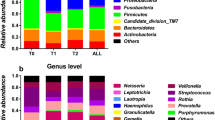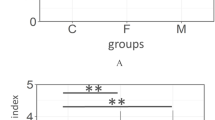Abstract
Previous studies of oral microbiota by culture-dependent or targeted DNA approaches demonstrated that hyposalivation, a reduction in salivary secretions, might increase the amount of certain oral pathogens. However, the relationship between hyposalivation and the balance of oral microbiota, especially uncultivable bacteria, remains still unclear. The aim of this study was to elucidate the relationship between hyposalivation and oral microbiota by analyzing terminal restriction fragment length polymorphism (T-RFLP) of 16S rDNA. The 61 subjects were divided into two groups, hyposalivation group and normo-salivation group. The microbiota of tongue-coating samples was analyzed by T-RFLP. The amount of saliva, the number of Candida albicans, and also the dental status including plaque index, gingival index, bleeding on probing, probing pocket depth and decayed, missing, and filled teeth (DMFT) were assessed. Regarding the dental status, none of the evaluated factors were significantly different between the groups except the number of DMFT. According to the T-RFLP profiles, the patterns of microbiota in the tongue coating were classified into two groups, Clusters I and II. Cluster I is made up 76 % of subjects with hyposalivation, while Cluster II is made up 61 % of subjects with normo-salivation (p < 0.001). Compared with the microbiota found in Cluster II, that in Cluster I had higher proportions of T-RFs corresponding to genera Veillonella, Dialister, Prevotella, Fusobacterium, and Streptococcus. T-RFLP analysis showed a significant role of salivary volume in determining the composition of the microbial community, regardless of the cultivability of the bacteria.



Similar content being viewed by others
References
Aas JA, Paster BJ, Stokes LN, Olsen I, Dewhirst FE (2005) Defining the normal bacterial flora of the oral cavity. J Clin Microbiol 43:5721–5732
Aas JA, Griffen AL, Dardis SR, Lee AM, Olsen I, Dewhirst FE, Leys EJ, Paster BJ (2008) Bacteria of dental caries in prim-ary and permanent teeth in children and young adults. J Clin Microbiol 46:1407–1417
Almståhl A, Wikstrom M (1999) Oral microflora in subjects with reduced salivary secretion. J Dent Res 78:1410–1416
Almståhl A, Wikstrom M, Fagerberg-Mohlin B (2008) Microflora in oral ecosystems in subjects with radiation-induced hyposalivation. Oral Dis 14:541–549
Antoniazzi RP, Miranda LA, Zanatta FB, Islabão AG, Gustafsson A, Chiapinotto GA, Oppermann RV (2009) Periodontal conditions of individuals with Sjögren’s syndrome. J Periodontol 80:429–435
Boutsi EA, Paikos S, Dafni UG, Moutsopoulos HM, Skopouli FN (2000) Dental and periodontal status of Sjögren’s syndrome. J Clin Periodontol 27:231–235
Bradshaw DJ, Marsh PD (1998) Analysis of pH-driven disruption of oral microbial communities in vitro. Caries Res 32:456–462
Engelbrektson A, Korzenik JR, Pittler A, Sanders ME, Klaenhammer TR, Kitts CL (2009) Probiotics to minimize the disruption of faecal microbiota in healthy subjects undergoing antibiotic therapy. J Med Microbiol 58:663–670
Ergun S, Cekici A, Topcuoglu N, Migliari DA, Külekçi G, Tanyeri H, Isik G (2010) Oral status and Candida colonization in patients with Sjögren’s syndrome. Med Oral Patol Oral Cir Bucal 15:e310–e315
Floyd ED, Tuste C, Jacques I, Bruce JP, Anne CRT, Wen-Han Y, Abirami L, William GW (2010) The human oral microbiome. J Bacteriol 192:5002–5017
Fujibayashi T, Sugai S, Miyasaka N, Hayashi Y, Tsubota K (2004) Revised Japanese criteria for Sjögren’s syndrome (1999): availability and validity. Mod Rheumatol 14:425–434
Fujinaka H, Takeshita T, Sato H, Yamamoto T, Nakamura J, Hase T, Yamashita Y (2013) Relationship of periodontal clinical parameters with bacterial composition in human dental plaque. Arch Microbiol 195:371–383
Kimori H, Nakagawa Y, Yamamoto K, Ohshima T (2009) Establishing the cut-off point for the Candida swab test for daily oral care in dry mouth patients. Oral Therap Pharmacol 28:17–24
Klamer M, Roberts MS, Levine LH, Drake BG, Garland JL (2002) Influence of elevated CO2 on the fungal community in a coastal scrub oak forest soil investigated with terminal-restriction fragment length polymorphism analysis. Appl Environ Microbiol 68:4370–4376
Kumar PS, Leys EJ, Bryk JM, Martinez FJ, Moeschberger ML, Griffen AL (2006) Changes in periodontal health status are associated with bacterial community shifts as assessed by quantitative 16S cloning and sequencing. J Clin Microbiol 44:3665–3673
Kuramitsu HK, He X, Lux R, Anderson MH, Shi W (2007) Interspecies interactions within oral microbial communities. Microbiol Mol Biol Rev 71:653–670
Kuru B, McCullough MJ, Yilmaz S, Porter SR (2002) Clinical and microbiological studies of periodontal disease in Sjögren syndrome patients. J Clin Periodontol 29:92–102
Leal SC, Bittar J, Portugal A, Falcão DP, Faber J, Zanotta P (2010) Medication in elderly people: its influence on salivary pattern, signs and symptoms of dry mouth. Gerodontology 27:129–133
Lenander-Lumikari M, Loimaranta V (2000) Saliva and dental caries. Adv Dent Res 14:40–47
Leung KC, McMillan AS, Leung WK, Wong MC, Lau CS, Mok TM (2004) Oral health condition and saliva flow in southern Chinese with Sjögren’s syndrome. Int Dent J 54:159–165
Leung KCM, Leung WK, McMillan AS (2007) Supra-gingival microbiota in Sjögren’s syndrome. Clin Oral Investig 11:415–423
Leung KCM, McMillan AS, Cheung BPK, Leung WK (2008) Sjögren’s syndrome sufferers have increased oral yeast levels despite regular dental care. Oral Dis 14:163–173
Li Y, Ge Y, Saxena D, Caufield PW (2007) Genetic profiling of the oral microbiota associated with severe early-childhood caries. J Clin Microbiol 45:81–87
Liu WT, Marsh TL, Cheng H, Forney LJ (1997) Characterization of microbial diversity by determining terminal restriction fragment length polymorphisms of genes encoding 16S rRNA. Appl Environ Microbiol 63:4516–4522
Löe H, Silness J (1963) Periodontal disease in pregnancy. I. Prevalence and severity. Acta Odontol Scand 21:533–551
Marsh PD (1994) Microbial ecology of dental plaque and its significance in health and disease. Adv Dent Res 8:263–271
Marton K, Madlena M, Banoczy J, Varga G, Fejerdy P, Sreebny LM, Nagy G (2008) Unstimulated whole saliva flow rate in relation to sicca symptoms in Hungary. Oral Dis 14:472–477
Nakano Y, Takeshita T, Kamio N, Shiota S, Shibata Y, Yasui M, Yamashita Y (2008) Development and application of a T-RFLP data analysis method using correlation coefficient matrices. J Microbiol Methods 75:501–505
Navazesh M, Christensen CM (1982) A comparison of whole mouth resting and stimulated salivary measurement procedures. J Dent Res 61:1158–1162
Odamaki T, Xioa J, Iwabuchi N, Sakamoto M, Takahashi N, Kondo S, Miyaji K, Iwatsuki K, Togashi H, Enomoto T, Benno Y (2007) Influence of Bifidobacterium longum BB536 intake on faecal microbiota in individuals with Japanese cedar pollinosis during the pollen season. J Med Microbiol 56:1301–1308
Ogawa H, Yoshihara A, Hirotomi T, Ando Y, Miyazaki H (2002) Risk factors for periodontal disease progression among elderly people. J Clin Periodontol 29:592–597
Oofuji T (1978) Review of research reports. Annual report of the ministry of health and welfare: Sjögren’s disease research committee 1977, Japan (in Japanese)
Rhodus NL, Michalowicz BS (2005) Periodontal status and sulcular Candida albicans colonization in patients with primary Sjögren’s syndrome. Quintessence Int 36:228–233
Sakamoto M, Takeuchi Y, Umeda M, Ishikawa I, Benno Y (2003) Application of terminal RFLP analysis to characterize oral bacterial flora in saliva of healthy subjects and patients with periodontitis. J Med Microbiol 52:79–89
Shinozaki S, Moriyama M, Hayashida JN, Tanaka A, Maehara T, Ieda S, Nakamura S (2012) Close association between oral Candida species and oral mucosal disorders in patients with xerostomia. Oral Dis 18:667–672
Ship JA, Pillemer SR, Baum BJ (2002) Xerostomia and the geriatric patient. J Am Geriatr Soc 50:535–543
Silness J, Löe H (1964) Periodontal disease in pregnancy. II. Correlation between oral hygiene and periodontal condition. Acta Odontol Scand 22:112–135
Takahashi N (2005) Microbial ecosystem in the oral cavity: metabolic diversity in an ecological niche and its relationship with oral diseases. Int Congr Ser 1284:103–112
Takahashi N, Nyvad B (2011) The role of bacteria in the caries process: ecological perspectives. J Dent Res 90:294–303
Takahashi N, Saito K, Schachtele CF, Yamada T (1997) Acid tolerance and acid-neutralizing activity of Porphyromonas gingivalis, Prevotella intermedia and Fusobacterium nucleatum. Oral Microbial Immunol 12:323–328
Takeshita T, Nakano Y, Yamashita Y (2007) Improved accuracy in terminal restriction fragment length polymorphism phylogenetic analysis using a novel internal size standard definition. Oral Microbiol Immunol 22:419–428
Takeshita T, Nakano Y, Kumagai T, Yasui M, Kamio N, Shibata Y, Shiota S, Yamashita Y (2009) The ecological proportion of indigenous bacterial populations in saliva is correlated with oral health status. ISME J 3:65–78
Takeshita T, Suzuki N, Nakano Y, Shimazaki Y, Yoneda M, Hirofuji T, Yamashita Y (2010) Relationship between oral malodor and the global composition of indigenous bacterial population in saliva. Appl Environ Microbiol 76:2806–2814
Vitali C, Bombardieri S, Jonsson R, Moutsopoulos HM, Alexander EL, Carsons SE, Daniels TE, Fox PC, Fox RI, Kassan SS, Pillemer SR, Talal N, Weisman MH, European Study Group on Classification Criteria for Sjögren’s Syndrome (2002) Classification criteria for Sjögren’s syndrome: a revised version of the European criteria proposed by the American-European Consensus Group. Ann Rheum Dis 61:554–558
Wiener RC, Wu B, Crout R, Wiener M, Plassman B, Kao E, McNeil D (2010) Hyposalivation and xerostomia in dentate older adults. J Am Dent Assoc 141:279–284
Author information
Authors and Affiliations
Corresponding author
Rights and permissions
About this article
Cite this article
Hayashi, Y., Saito, T., Ohshima, T. et al. Terminal RFLP analysis to determine the oral microbiota with hyposalivation. Arch Microbiol 196, 489–496 (2014). https://doi.org/10.1007/s00203-014-0987-x
Received:
Accepted:
Published:
Issue Date:
DOI: https://doi.org/10.1007/s00203-014-0987-x




